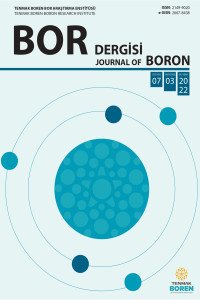Synthesis of active platinum particles on the activated carbon with sodium borhydride as reduction agent
Öz
Platinum nanoparticles on the activated carbon surface were obtained by chemical reduction of hexachloroplatinic acid (H2PtCl6) with different reducing agents. Sodium borohydride, formic acid and formaldehyde were chosen as reducing agents. In this study, the effects of the reducing agent on the uniform distribution and structure of platinum particles on activated carbon were investigated. The morphology and microstructure of the obtained products were characterized by SEM, phase characterization by XRD and surface area and pore distributions by BET method. The obtained results showed that the use of sodium borohydride as a reducing agent provides optimum conditions for obtaining homogeneous platinum nanoparticles on the activated carbon surface.
Anahtar Kelimeler
Kaynakça
- Referans1 Alegre, C.; Calvillo, L.; Moliner, R.; González-Expósito, J.A.; Guillén-Villafuerte, O.; Martínez Huerta, M.V.; Pastor, E.; Lázaro, M.J. Pt and PtRu electrocatalysts supported on carbon xerogels for direct methanol fuel cells. J. Power Sources 2011, 196, 4226–4235.
- Referans2 Santiago, E.I., Paganin, V.A., Carmo, M., Gonzalez, E.R., Ticianelli, E.A., “Studies of CO tolerance on Modified Gas Diffusion Electrodes Containing Ruthenium Dispersed on Carbon”, Journal of Electroanalytical Chemistry, 575:53-60 (2005).
- Referans3 Verde-Gomez, Y., Alonso-Nunez, G., Cervantes, F., Keer, A., “Aqueous Solution Reaction to Synthesize Ammonium Hexachloroplatinate and Its Crystallographic and Thermogravimetric Characterization”, Materials Letters, 57: 4667-4672 (2003).
- Referans4 Wang, H., Sun, X., Ye, Y., Qiu, S., “Radiation Induced Synthesis of Pt Nanoparticles Supported on Carbon Nanotubes” Journal of Power Sources, 161(2):839-842 (2006).
- Referans5 (5) In Chul Hwang, Jong Heop Yi, Pil Kim, Ji Bong Joo, US7838458 B2, “Method for Preparing Highly Dispersed Supported Platinum U.S. Patent Documents Catalyst Using Complex Reducing Agent”
- Referans6 Vinod M. Jalan, Douglas A. Landsman, US4186110 “Noble Metal-Refractory Metal Alloys As Catalysts And Method For Making”.
- Referans7 Berceste Beyribey, Burcu Çorbacıoğlu, Zehra Altın, “Synthesis of Platinum Particles from H2PtCl6 with Hydrazine as Reducing Agent” G.U. Journal of Science 22(4): 351-357 (2009).
- Referans8 M. Gurrath , T. Kuretzky , H.P. Boehm , L.B. Okhlopkova , A.S. Lisitsyn , A. Likholobov, 2000, “Palladium catalysts on activated carbon supports Influence of reduction temperature, origin of the support and pretreatments of the carbon surface”, Carbon 38, 1241–1255.
- Referans9 Grün, M. U. (1999). Novel pathways for the preparation of mesoporous MCM-41 materials: control of porosity and morphology. Microporous and Mesoporous Materials(27), s. 207–216.
- Referans10 Bourja, L.; Bakiz, B.; Benlhachemi, A.; Ezahri, M.; . Villain, SJ.; Gavarri, R. 2010, “Synthesis and characterization of nanosized Ce1-xbixo2-δ solid solutions for catalytic applications”, TUSCI 4: 1-8.
- Referans11 Maillard, F.; Savinova, E.R.; Simonov, P.A.; Zaikovskii, V.I.; Stimming, U. Infrared Spectroscopic Study of CO Adsorption and Electro-oxidation on Carbon-Supported Pt Nanoparticles: Interparticle versus Intraparticle Heterogeneity. J. Phys. Chem. 2004, 108, 17893–17904.
İndirgeyici ajan olan sodyum borhidrür ile aktif karbon yüzeyinde aktif platin parçacıklarının sentezi
Öz
Aktif karbon yüzeyinde platin nanopartiküller, hekzakloroplatinik asidin (H2PtCl6) farklı indirgenlerle kimyasal indirgenmesiyle elde edilmiştir. İndirgeyici ajan olarak sodyum borhidrür, formik asit ve formaldehit seçilmiştir. Bu çalışmada platin parçacıklarının aktif karbon yüzeyindeki dağılımı ve yapısı üzerinde indirgeyici ajan seçiminin etkileri incelenmiştir. Elde edilen ürünlerin morfolojisi ve mikro yapısı taramalı elektron mikroskobu (SEM), faz karakterizasyonu X ışını kırınım spektrometre (XRD) ve yüzey alanı ile gözenek boyut dağılımları azot adsorpsiyon izoterminden BET yöntemi ile hesaplanarak belirlenmiştir. Elde edilen sonuçlar, indirgeyici ajan olarak sodyum borhidrürün kullanımının aktif karbon yüzeyinde homojen platin nanoparçacıklarının eldesi için optimum koşullar sunduğunu göstermiştir.
Anahtar Kelimeler
Kaynakça
- Referans1 Alegre, C.; Calvillo, L.; Moliner, R.; González-Expósito, J.A.; Guillén-Villafuerte, O.; Martínez Huerta, M.V.; Pastor, E.; Lázaro, M.J. Pt and PtRu electrocatalysts supported on carbon xerogels for direct methanol fuel cells. J. Power Sources 2011, 196, 4226–4235.
- Referans2 Santiago, E.I., Paganin, V.A., Carmo, M., Gonzalez, E.R., Ticianelli, E.A., “Studies of CO tolerance on Modified Gas Diffusion Electrodes Containing Ruthenium Dispersed on Carbon”, Journal of Electroanalytical Chemistry, 575:53-60 (2005).
- Referans3 Verde-Gomez, Y., Alonso-Nunez, G., Cervantes, F., Keer, A., “Aqueous Solution Reaction to Synthesize Ammonium Hexachloroplatinate and Its Crystallographic and Thermogravimetric Characterization”, Materials Letters, 57: 4667-4672 (2003).
- Referans4 Wang, H., Sun, X., Ye, Y., Qiu, S., “Radiation Induced Synthesis of Pt Nanoparticles Supported on Carbon Nanotubes” Journal of Power Sources, 161(2):839-842 (2006).
- Referans5 (5) In Chul Hwang, Jong Heop Yi, Pil Kim, Ji Bong Joo, US7838458 B2, “Method for Preparing Highly Dispersed Supported Platinum U.S. Patent Documents Catalyst Using Complex Reducing Agent”
- Referans6 Vinod M. Jalan, Douglas A. Landsman, US4186110 “Noble Metal-Refractory Metal Alloys As Catalysts And Method For Making”.
- Referans7 Berceste Beyribey, Burcu Çorbacıoğlu, Zehra Altın, “Synthesis of Platinum Particles from H2PtCl6 with Hydrazine as Reducing Agent” G.U. Journal of Science 22(4): 351-357 (2009).
- Referans8 M. Gurrath , T. Kuretzky , H.P. Boehm , L.B. Okhlopkova , A.S. Lisitsyn , A. Likholobov, 2000, “Palladium catalysts on activated carbon supports Influence of reduction temperature, origin of the support and pretreatments of the carbon surface”, Carbon 38, 1241–1255.
- Referans9 Grün, M. U. (1999). Novel pathways for the preparation of mesoporous MCM-41 materials: control of porosity and morphology. Microporous and Mesoporous Materials(27), s. 207–216.
- Referans10 Bourja, L.; Bakiz, B.; Benlhachemi, A.; Ezahri, M.; . Villain, SJ.; Gavarri, R. 2010, “Synthesis and characterization of nanosized Ce1-xbixo2-δ solid solutions for catalytic applications”, TUSCI 4: 1-8.
- Referans11 Maillard, F.; Savinova, E.R.; Simonov, P.A.; Zaikovskii, V.I.; Stimming, U. Infrared Spectroscopic Study of CO Adsorption and Electro-oxidation on Carbon-Supported Pt Nanoparticles: Interparticle versus Intraparticle Heterogeneity. J. Phys. Chem. 2004, 108, 17893–17904.
Ayrıntılar
| Birincil Dil | Türkçe |
|---|---|
| Bölüm | Araştırma Makaleleri |
| Yazarlar | |
| Yayımlanma Tarihi | 30 Eylül 2022 |
| Kabul Tarihi | 22 Temmuz 2022 |
| Yayımlandığı Sayı | Yıl 2022 Cilt: 7 Sayı: 3 |
Journal of Boron by Turkish Energy Nuclear Mineral Research Agency is licensed under CC BY-NC-SA 4.0


